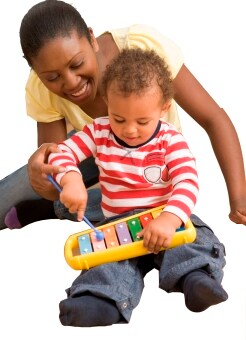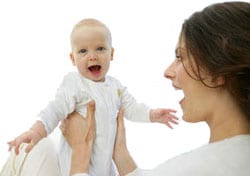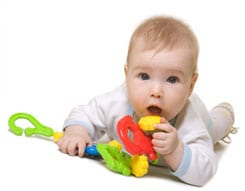Kindergarten
Once upon a time, kindergarten was
all about teaching social readiness, learning how to line up, sit quietly in a
circle, and put things back. In recent decades, "readiness skills" in
language, reading, writing, and math have been emphasized. Experts generally
agree, however, that much of the "learning" that happens in
kindergarten should be nonacademic. Make-believe and fantasy are a big part of
the kindergartner's approach to the world. Enjoy it.
What to Expect
1. Lots of activity. Kindergartners
are doers, not sitters. While children will learn, increasingly, how to sit
still and listen, the emphasis in the classroom will be on hands-on reality and
action, action, action, both indoors and out.
2. Imagination! Children in
kindergarten are, in some ways, at the imaginative peak of their lives.
Kindergarten should make the most of this special time. That is what the paints
and dress-up clothes and blocks and Play-Doh are for.
3. Learning letters. The most common
formal instruction in kindergarten is the teaching of the alphabet and its
associated sounds. Teachers will teach this to an incredibly diverse crew: Some
children will already know how to read, while others will struggle with the
letters all year and may still not know them well.
4. Families and holidays. Social
studies do not usually exist, per se, in kindergarten. But the rudiments begin
as the teacher encourages a discussion of families. Holidays are useful, too.
They're fun, they teach about customs and other people, and offer many
arts-and-crafts-related tie-ins.
5. Ongoing social and physical
maturity. As the year moves along, your kindergartner should demonstrate an
increased understanding of rules and cooperation, a longer attention span, and
better coordination.
6. Print curiosity. Another feature
that may emerge toward the end of the year, if not before, is a marked
curiosity about printed words your child sees -- on signs, boxes of food,
stray household objects, even clothing labels.
Watch Out for:
- Toilet accidents. While not uncommon, some of
these are avoidable if you help your child learn how to make his needs
known to the teacher. Some are quite shy about this.
- Not getting along? A persistent inability to
share or a lack of playmates may indicate a problem that deserves
attention.
First Grade
Elementary school begins in first
grade. But in spirit, children begin first grade as kindergartners. Much
happens over the course of the year to transform little children into young
boys and girls. First-graders do not seem as wild as kindergartners --
after all, they are more developed physically, neurologically, and
psychologically. They are gaining more control over their bodies, both at the
fine motor level (first-grade art often shows a big representational leap over
kindergarten art) and at the large muscle level (first grade is when children
often begin to show interest in specific sports). Your child has a better sense
of self than she did a year ago, and less of a need to live in the here and
now. And she is ready and willing to use her mind. This is what first grade is
all about. It is a fun and fulfilling year.
What to Expect
1. A big emphasis on reading.
Children range from reading fluently as preschoolers to still being unsure of
their letters when they leave kindergarten.
2. Numbers, numbers, and more
numbers. There is lots of math in first grade -- and it all seems like fun:
sorting and classifying, reading and writing numerals, seeking patterns,
working with tallying and statistics, exploring shapes and measurement.
3. A little bit of homework. These
days, most first-grade teachers tend to give a few minutes of homework once or
twice a week to reinforce some classroom lessons.
4. Writing, but not spelling.
First-graders are given many chances to write. But what is on a child's mind at
this age can outstrip his physical ability to hold the pencil and form the
letters. Acceptance of "inventive" spelling is another part of
helping children embrace the writing process.
5. Increased emotional and physical
independence. Children quickly learn to walk into the classroom themselves,
then progress into other areas of self-management, such as hanging up coats (as
the weather cools), returning library books, and handing in homework.
6. Concentration. Kindergartners
learn to listen in a circle; first-graders sit at their desks and listen to
what is going on without getting distracted or requiring attention. This
ability to concentrate develops over the course of the year, and sets the stage
for second-grade academics.
Watch Out for:
- ·
Slow readers. Do
your best not to pressure your child into reading if he does not seem eager,
and try not to force him to show you what he has been learning. How quickly a
child learns to read has nothing to do with overall brightness or long-term
reading ability.
- ·
Too much
television. Research has shown that limiting television to 10 hours or less a
week may assist a child in his reading; more TV-watching has been shown to slow
reading achievement.
- ·
Pent-up feelings.
First-graders are still emotional beings, likely to cry, yell, hit, or even
throw tantrums when upset. This is a good age to begin urging your child to
talk about feelings, and to guide her in beginning to find her own solutions to
problems.
Second Grade
In second grade, a
child becomes a student. By now, children should have a strong grip on all the
rudimentary skills of learning, from reading and writing to arithmetic. With
evident pride in what they know, second-graders are among the most eager
learners to be found. They tend to be attached to the literal and concrete, and
begin to pay attention to the world around them and expect to have some input
and control. But they are still marvelously open to new experiences, and they
have an appetite for stories, poetry, music, and other arts-oriented
activities.
What to Expect
1. Reading. The emphasis this year
moves from reading as "decoding" (being able to convert letters into
sounds; combining the sounds into words) to reading for understanding.
(Second-graders, however, still love being read to, so teachers should provide
regular story time.)
2. Real homework. Though not
generally time-consuming, second-grade homework usually becomes regular,
perhaps 15 to 20 minutes a night. It is a good grade to begin a homework
routine: Decide on the time and place homework gets done and see that your
child stays with it as much as her schedule permits.
3. Uh-oh: Spelling! In most schools,
second grade marks the beginning of the spelling curriculum. There may be
textbooks, photocopied lists, tests, or some combination of these, all in the interest
of introducing children to the idea that spelling does matter after all.
4. Math as a subject. If not before,
this is the year that math becomes a formal subject of instruction (best taught
in the morning when children are more alert). Math moves beyond counting into
more complex addition and subtraction, simple fractions, measurement, and
problem solving.
5. Journalizing. Second grade is a
big journal year. Children write about everything that happens to them, and in
the process create one of the most adorable and enduring documents of their
school careers.
6. Outside experiences. While your
child may already have a history of extracurricular activities, in second grade
she may, suddenly, begin to express her own ideas about what she would like to
be doing outside of school.
Watch Out for:
- ·
Excessive
self-criticism. A second-grader will notice how his friends and peers do things
and compare his own abilities. He may need help putting self-criticism in
perspective and not judging himself too harshly.
- ·
Lack of
concentration. Children who still have trouble sitting still and listening will
begin to have trouble achieving at a high level.
- ·
Slow readers,
redux. As the year passes the halfway point, if your child is still struggling
with reading, it may be time to confer with the teacher.
Third Grade
School gets more
serious in third grade. And so do the children. They begin to become aware of
themselves in a wider context than children in a family. Third-graders can now
draw on their own mental resources (memories, problem-solving skills, personal
experience) when learning something new. In third grade, school becomes not
just a place of learning, but also a place of socializing; children look
forward to seeing their friends there day after day after day.
What to Expect
1. "Big kid"
responsibilities. Children will be expected to pack and unpack their own
backpacks, write down their own homework assignments, and hand in their work.
Third-grade homework moves into the 20- to 30-minute range.
2. Textbooks. Many schools shift much
of the curriculum into textbooks in third grade, often for spelling and social
studies, although this varies a lot by school system.
3. Group work and projects. Third
grade is project heaven, with hands-on science experiments, literary dioramas,
and social studies construction projects providing varied and colorful activity
-- and a lot of fun -- throughout the year.
4. Writing gets sophisticated.
Children curb their self-expression and become more self-conscious in their
writing, as they are taught more explicitly about crafting prose and poetry.
And, adding style to substance, cursive is typically introduced during the
third-grade year.
5. Fruitful multiplication.
Multiplication "facts," as they are usually called these days, fly
hot and heavy around the third-grade classroom. The goal is to have all
single-digit multiplication down cold by the end of the year.
6. Instrumental music. If your school
has a music program, your child may learn the recorder in third grade. If there
is no music program in the school, this is a good age to pursue lessons on the
outside.
Watch Out for:
- § School blahs. This can be a make-or-break year regarding your child's
attitude toward school. Try to foster a positive attitude about learning.
- § Grade pressure. Grades are a guide to what your child has learned and
what she still needs to learn, no more; not a reason to pressure your child.
- § Gender rivalry. In third grade, boys and girls dissociate, flagrantly.
Same-sex clusters rule the day. This is not anything to worry about --
just funny.
Fourth Grade
In fourth grade,
for perhaps the first time, school can get tough. Gone is the gentle focus of
younger-grade teachers on basic skills and social development. Now, there are
hard subjects to grapple with, more schoolwork and homework to organize, and
real tests to study for -- as the saying goes, in fourth grade, children
stop learning to read and start reading to learn. What is more, fourth-graders
must navigate an increasingly complex social environment, with new sensitivity
to who the "smart" ones or "popular" ones are.
Fourth-graders are not as ready to distance themselves from their parents as
children another year or two down the road. For some it is the last innocent
year.
What to Expect
1. Homework gets serious. If your child does not have a homework routine
in place, he might find himself overwhelmed as fourth grade -- with its
40 minutes or more of homework -- gets under way. And now there are
plenty of real tests to study for. Be sure your child's organizational skills
are up to the task without being too bossy yourself.
2. Three-ring binders. The next sign of a maturing student, after the
textbooks in third grade, are the three-ring binders (complete with dividers)
of the fourth-grader.
3. State history. Expect to find out more than you yourself ever knew
about the state you live in.
4. Shapes of things. While fourth-grade math is largely an extension of
third-grade math (more multiplication, more division, more fractions), there is
also more geometry, which often fascinates children this age.
5. Researching skills. One of the ways fourth-graders utilize their
reading skills is by learning how to apply reading to gather information and to
understand other subjects -- especially history, geography, and science.
6. Physical differences. Fourth grade is marked by potentially large
physical differences in children. While some still look young, others look
nearly ready for middle school.
Watch Out for:
- § Math hesitancy. If your fourth-grader considers math "hard,"
talk to the teacher. Fourth-grade math should not be beyond most children's
abilities.
- § Sensitive feelings. In cliques and rivalries brews much opportunity for
hurt feelings. Friendships can also bring tension and conflict. On top of this,
fourth-graders are more sensitive than younger children to what other people think
of them.
- § The end of reading at home. Just because your child is old enough to
read on his own does not mean you should stop reading to him out loud. Most
children still love this time with their parents.
Fifth Grade
In many schools,
the fifth-graders are the oldest, and they love it. While they still tend to
have a natural love of learning, they are also moving toward preadolescence.
Some are more willing than ever before to test their limits, question
authority, and be distracted by nonacademic activities. That said, many
fifth-graders are still happy children, keen on acquiring knowledge and
learning facts. This is a year, too, in which technical proficiency in special
areas, such as music, may blossom. While fifth grade is a lot like fourth grade
in the academic ground it covers, fifth-graders are expected to act with an
ever-increasing amount of independence and responsibility.
What to Expect
1. Long-term research projects and reports. In fifth grade, reports get
longer, require independent research, and delve into more complex materials. If
there is a computer at home, you may suddenly see your child doing more than
playing on it. The Web may become a useful resource.
2. Current events. Regardless of the appropriateness of the news for
children, fifth-graders are captivated by the world around them, and will often
have assignments oriented toward reading the newspaper.
3. Public speaking. Dynamic fifth-grade classes encourage a lot of
public speaking opportunities -- from writing and delivering actual
speeches, to a variety of chances for oral presentations. Attend to how your
child handles this.
4. Math gets hard. Maybe not for your child, but for you. Parents often
find that fifth-grade math takes them beyond what they comfortably remember. As
in fourth grade, it's crucial for you to stay in touch with your child's
mathematical progress, or lack of progress.
5. Sex in the classroom? The time has come, in fifth grade in most
schools, for presentations on health and sexuality. Bodies will be changing
soon -- it's natural, and so, too, should be learning about it.
6. Fifth-grade events. Especially as the spring arrives, fifth grade may
end up seeming to be, most of all, about itself: A celebration of the upcoming
graduation and the end of the elementary-school career, through a series of
special events, often including a major field trip.
Watch Out for:
- "Forgotten" homework. Fifth grade is a big year for nightly
calls about homework. If your child is making, rather than receiving, these
calls, explore the reasons -- there could be organizational problems
- § Overscheduling. Inherently busy and social, your fifth-grader may end up
with little time to do her homework and get a good night's sleep.
- § Peer pressure. Fifth-graders can become very sensitive to having the
"right" clothes, hairstyles, and musical tastes. Be aware of this,
but be sure, too, not to approach conversations with your child judgmentally.
Keeping the lines of communication open will be one of your greatest
challenges.
Sixth Grade
In the old days
-- -say, when you were in grade school -- -sixth grade was part of
elementary school. Nowadays, that's less common. Sixth is often the first grade
in middle school; there are even some schools that are entirely sixth grade.
But wherever sixth grade happens, the children are the same age, going through
that same preteen confusion-laced excitement. Sixth-graders have been trained
to think for themselves and they're more than prepared to do that now, with
much vigor. They like to complain a lot, too, so brace yourself. And if you
haven't yet done this too well, take a crash course in learning how to let go:
Sixth-graders demand a lot of independence, even as they are not always
emotionally ready for it.
What to Expect
1. Transition-related challenges. For many, sixth grade is the first
year of middle school, and with it comes a new type of school day: multiple
teachers, changing classes, larger building, decreased parental input, and new
grading procedures and testing logistics.
2. Fifth grade, redux. When all is said and done, sixth grade is not all
that much different from fifth when it comes to content, with perhaps an added
focus on "thematic units" of study. Teachers use the year to identify
weaknesses and shore up skills students will need as they proceed into the
upper grades of middle school.
3. Longer-term reading assignments. Time budgeting skills begun in fifth
grade become important when pacing out week-long, or even month-long,
assignments.
4. "Grown-up" work. Sixth-graders like the trappings of
adult-style work, including detailed research, constructing bibliographies, and
complex mathematical reasoning. They will get all of this and more, in all
their classes.
5. Math struggles to stay relevant. Sixth-graders are very capable of
dealing with elaborate computations, understanding patterns and probability,
and solving logic problems -- but they still have trouble (as many of us
do!) fully understanding math as a stand-alone subject. Math works best
integrated with science, social studies, and language arts. Not all schools
manage to do this.
6. Ancient worlds. They're still studying ancient civilizations in sixth
grade, much as you might remember. But in addition to the usual suspects,
Egypt, Greece, and Rome, schools today often head, multiculturally, toward
India and China as well.
7. Computerization. While not all elementary schools are equally wired,
and the benefits of the computer continue to be debated at the grade-school
level, there is no doubt that computers become a key part of the middle-school
environment.
Watch Out for:
- § Homework nightmares. Some schools are better than others at instituting
a global sense of homework. Many students face an onslaught of unprecedented
proportions thanks to having multiple teachers. Word has it that the homework
situation smooths out by seventh grade.
- § Communication breakdown. Because of what sixth-graders are going through
emotionally, they may become far less interested in discussing things with
their parents. Don't stop trying, however. Children still want and need
parental guidance. Use new approaches. Just when your child may begin to act as
if he deserves less respect is exactly when you need to treat him with more.
- § Social flux and uncertainty. Peer pressure kicks in big time, along with
cliques and other difficult new social realities, including dating.
- § Symptoms of stress. When sixth grade is the first year of middle school,
some children are at risk for serious stress. Keep an eye on your child and
make sure her needs (good nutrition, a decent night's sleep, physical exercise)
are being met.




